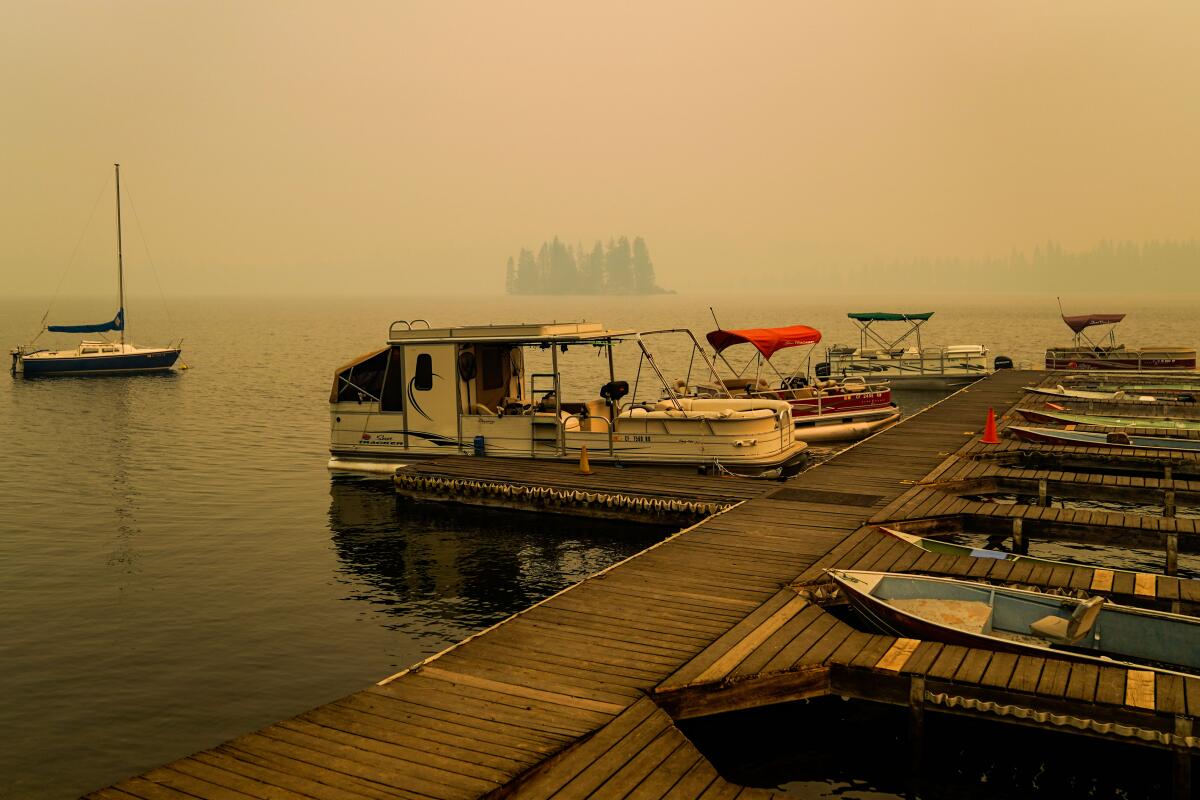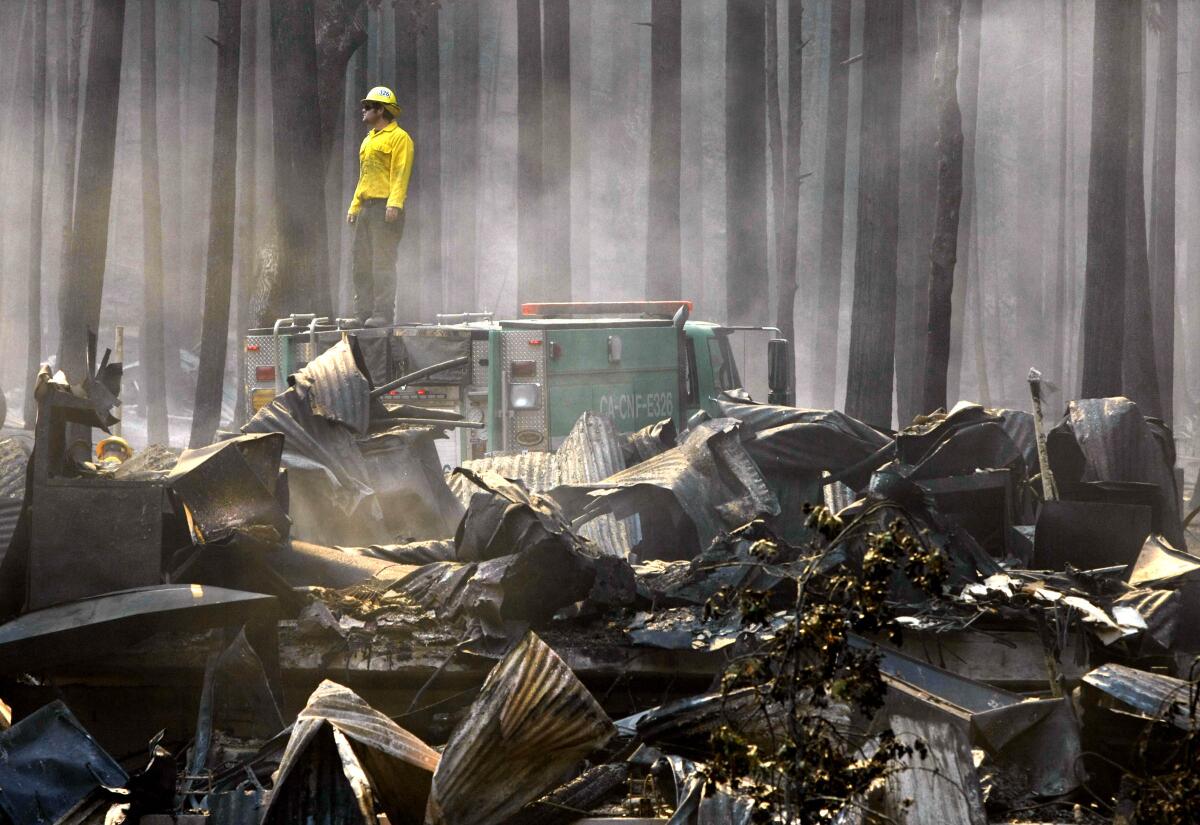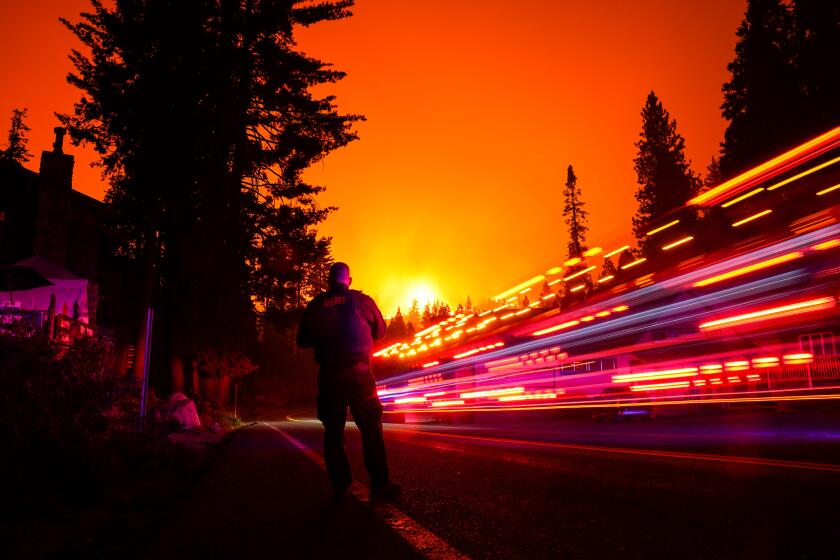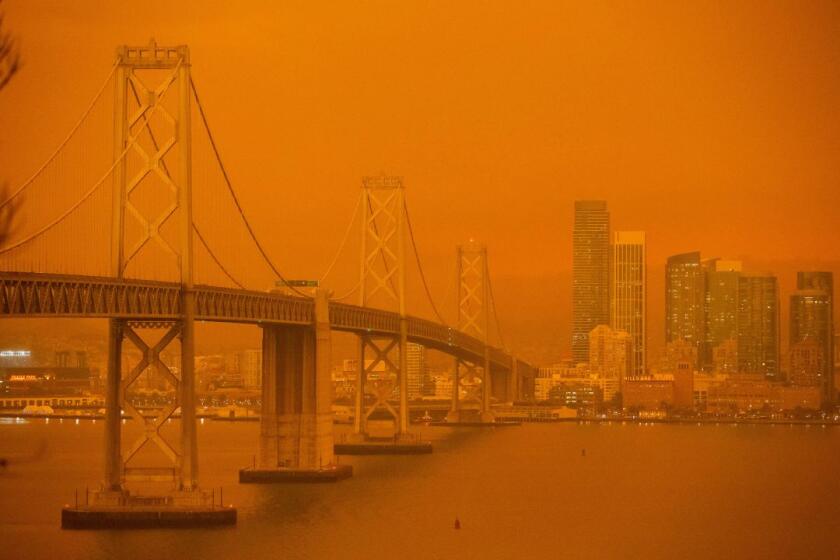Infernos, smoke and heat waves threaten summer youth camps across the West

- Share via
As California parents sign up their offspring for summer camp amid forecasts of another potentially catastrophic wildfire season, an existential question looms over the annual ritual: Will camp still be standing come July?
The climate-driven megafires of recent years are threatening the future of summer camps, endangering a century-old tradition of spending school holidays in the pristine pine-scented air of the state’s lushly forested mountain ranges. Since 2013, wildfires in California have destroyed historic summer camps from Malibu to Tahoe. Urban camps, meanwhile are adapting to a new climate of uncertainty as heat waves and toxic smoke from faraway fires upend their business.
“When there’s a fire. you’re looking at heat maps and wondering if this place you love is still there,” says Andy Moeschberger, director of Gold Arrow Camp in the Sierra Nevada Mountains south of Yosemite National Park.
The camp founded on the shores of Huntington Lake in 1933 lost buildings in the September 2020 Creek fire that burned nearly 380,000 acres in the Sierra National Forest. “We were fortunate we didn’t have campers on site at the time,” says Moeschberger. “You’re in crisis because your business and livelihood is burning down and generations of kids are emailing you about what’s going on.”
That anxiety is compounded by the reality that the fire next time probably would be the last for many camps. As wildfires become more extreme, widespread and perennial, insurers have canceled policies or raised rates dramatically for a fraction of the coverage previously offered.
Moeschberger says camps are already reeling from the loss of income from the COVID-19 pandemic and rising food and energy prices. “As a business, you’re operating knowing that if your camp burns, the likelihood of recovering money to rebuild it is almost zero,” he says.
Creek fire cuts a path through a family’s small empire in the Sierra Nevada. Would any of it survive?
It’s not just a California crisis.
“Over the past three years we’ve seen significant damage to camps in the West, particularly in California, Colorado and Arizona,” says Tom Rosenberg, chief executive officer of the American Camp Assn., an accreditation body for 2,400 camps in the United States. “Wildfires and smoke associated with fires have become major issues for summer camps in the 13 Western states and heat waves are also more intense and frequent.”
In 2020 and 2021, about 73 camps in the West were damaged or had to evacuate because of wildfires, according to the association, while smoke forced the closure of many others.
That means in addition to planning singalongs and canoe races, camp directors are now plotting evacuation routes, monitoring atmospheric conditions and, if fire threatens, keeping buses at the ready to whisk campers to safety.
Growing wildfire danger has prompted some parents to reconsider the risks of what once was summer camps’ biggest draw — a remote location where kids could go off-the-grid and be immersed in nature.
Kelly Huston and his husband have sent their 13-year-old son to a Sierra Nevada camp for the last four summers. “This year we chose to enroll him in the first available weeks of the camp, because honestly, we thought there was at least a little bit less risk of wildfire earlier in the season than later on,” says Huston, a senior policy advisor at the California Labor and Workforce Development Agency.
“I’m also trying to figure out how adequate evacuation plans are up there,” adds Huston, who previously served as deputy director of the California Governor’s Office of Emergency Services. “Camps can’t rely on receiving a warning as wildfires now move too fast. They have to be able to act on their own and decide what’s the threshold for evacuating hundreds of children from a camp that’s way up in the hills and accessible only on a two-lane road.”
For the city of Berkeley, which operates a pair of 100-year-old camps in the Sierra Nevada, the August 2013 Rim fire was a wake-up call. It was California’s second-largest wildfire on record at the time and a harbinger of the megafires to come. As the Rim fire spread toward Berkeley Tuolumne Camp west of Yosemite, the city hired a bus company on standby in case campers needed to be evacuated.

“We thought we had a day or two but we only had hours,” says Scott Ferris, director of parks, recreation and waterfront for Berkeley. “Right after we got our campers out, the fire was coming over the hill.”
It incinerated the verdant camp beloved by generations of Berkeley residents. So last August when the fast-moving Caldor fire barreled toward the city’s Echo Lake Camp near Lake Tahoe, officials were ready. Campers were sent home early and the Berkeley Fire Department deployed a unit to Echo Lake to secure water supplies, clear vegetation and take other protective measures. The firefighters returned as the conflagration approached and spent several days defending the camp.
“Without their presence that place would have burned,” says Ferris.
This June, Berkeley Tuolumne Camp will reopen after a nine-year rebuilding project. Before the Rim fire, the 300-person family camp on the South Fork of the Tuolumne River in the Stanislaus National Forest was barely visible through thick stands of towering Ponderosa pine, Douglas fir and cedar that covered hillsides and shaded the camp’s swimming hole.
“Right after we got our campers out, the fire was coming over the hill.”
— Scott Ferris, director of parks, recreation and waterfront for the city of Berkeley.
Nearly a decade after the fire, the landscape still looks like a concussion bomb detonated. On a visit in late March, some two dozen new wood-framed tent cabins climb a denuded hillside overlooking the nearly finished amphitheater, dining hall and recreation center. Pines spared in the fire sparsely dot the surrounding hillsides.
Liza McNulty, Berkeley’s Tuolumne project manager, says about 2,000 potentially hazardous trees were removed in the wake of the fire. On this day, she is supervising a group of volunteers who are planting seedlings in the charred hills.
The new buildings were designed to resemble the historic Tuolumne camp but constructed to comply with the state’s stringent fire codes. Cabins that once were crammed cheek-to-jowl now sit 10 feet apart.
McNulty points to a hill topped with a new 240,000-gallon water tank that supplies fire hydrants installed throughout the rebuilt camp. “Even the selection and placement of the trees and plants all has been done with the overlay of long-term fire management,” she says.
Insurance paid for most of the $55-million rebuilding cost; today it would cover only $5 million, according to Ferris. “If Berkeley Tuolumne Camp burns down again, there’s no way it’s going to be replaced,” he says.
It will take years to rebuild two iconic Southern California Jewish summer camps that burned in the November 2018 Woolsey fire. The late Rabbi Alfred Wolf of Los Angeles’ Wilshire Boulevard Temple established Camp Hess Kramer in 1952 in the canyons above Malibu. Sixteen years later, Wolf, who fled Nazi Germany as a young man, started the adjacent Gindling Hilltop Camp, opening the 187-acre sites to children across Southern California.
“Coming from Nazi Germany, my grandfather founded this camp because he wanted people of all faiths, creeds, religions and cultures to be able to freely enjoy their childhood,” says Aaron Wolf, a Los Angeles filmmaker.
It’s a cloudless April day and Wolf is standing next to an expanse of thigh-high plants covering what once was Camp Hess Kramer’s half-size Olympic swimming pool. It survived the fire but subsequent mudslides entombed the pool and destroyed bridges and buildings.
“People were devastated by the loss of the camps,” says Wolf, who spent childhood summers and Thanksgivings at Hess Kramer. “There’s a lot of people from all walks of life who say the foundation of who they are is because of their experiences here.”
Amid birdsong and fluttering monarch butterflies, chaparral and purple and yellow wildflowers are reclaiming the canyon and sprouting from a stone amphitheater, giving the camp the air of an ancient ruin. A charred menorah stands over an outdoor chapel encircled by burnt trees and flooded with mud. The fire torched all the cabins that stretched up a hill save one, named for Wolf’s grandmother Miriam. As it burned through the camp to the coast, the fire left untouched a wood sign marking the Rabbi Alfred Wolf Inspiration Point, where a large metal menorah overlooks surfers bobbing in the waves below.
A document the Wilshire Boulevard Temple filed in 2019 indicates the challenges of rebuilding as it pursues insurance claims and approval from a plethora of government agencies. Besides buildings, roads, bridges, water pipes, electrical lines and a wastewater treatment system must be repaired or replaced. The estimated price tag: more than $52 million.
Heather Mitchell says she is still able to obtain insurance for Monkey Business Camp, the Berkeley day camp she co-founded 24 years ago that holds summer sessions at a forested regional park in the city’s hills. But the policy does not cover losses if Monkey Business is forced to shut down due to smoke or the threat of wildfires. Since 2017, fires burning hundreds of miles away have periodically shrouded the San Francisco Bay Area in smoke so thick it blots out the sun.
Light scattering from smoke and volcanoes is the reason behind red skies
“One of our primary missions is to bring kids outside, so our summer camps are the ones most impacted by poor air quality,” says Mitchell. She is now developing an online camp program in case campers have to stay home some days this summer.
California’s record-breaking drought is also affecting camps. “One thing new this year is that the park says that we might have to haul in our own water,” says Mitchell.
For Monkey Business’ indoor winter holiday camps, she now stocks up on air filters and masks for outdoor play. “We had to figure out on-the-fly protocols for how much time the kids could spend outside.”
Gold Arrow camp director Moeschberger says the company’s day camp in Los Angeles has had to cancel sessions due to bad air quality. “Whether it’s smoke or evacuation, you’re losing a chunk of your season and that’s really hard financially,” he says.
“It seems like we’re in the fun business and it’s all shaving cream pies and silly songs,” Moeschberger adds. “But underneath the duck is paddling hard.”
More to Read
Sign up for Essential California
The most important California stories and recommendations in your inbox every morning.
You may occasionally receive promotional content from the Los Angeles Times.












